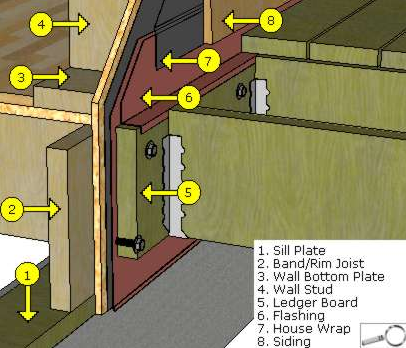Two of the most common problems found with decks are related to the ledger board. This critical part of the deck is what keeps it where you want it: attached to the house and off of the ground.
What is a Ledger Board?
The ledger board is a horizontal piece of lumber typically made from pressure-treated wood that's securely fastened to the exterior wall of your house. It acts as the anchor for your deck, literally carrying the weight of the entire structure – the deck joists, decking boards, furniture, and of course, the people enjoying it.
The ledger board is a horizontal piece of lumber typically made from pressure-treated wood that's securely fastened to the exterior wall of your house. It acts as the anchor for your deck, literally carrying the weight of the entire structure – the deck joists, decking boards, furniture, and of course, the people enjoying it.
Why is a Properly Installed Ledger Board Crucial?
A compromised ledger board can have disastrous consequences. Here's why proper installation is essential:
A compromised ledger board can have disastrous consequences. Here's why proper installation is essential:
- Structural Support: The ledger board transfers the deck's weight to the house's framing system. A weak or improperly attached ledger board can lead to deck sagging, instability, and even collapse.
- Moisture Protection: The ledger board forms a critical connection point between your deck and your house. Improper installation, especially without proper flashing, can allow moisture to seep between the ledger and the house wall, causing rot and structural damage.
Ensuring a Secure Ledger Board:
There are key elements to a secure ledger board installation:
There are key elements to a secure ledger board installation:
- Material: Use pressure-treated lumber specifically designed to withstand outdoor elements.
- Attachment: The ledger board should be securely bolted to the house's structural framing, not just the siding. This provides shear strength (holding the deck up) as well as lateral strength (preventing the deck from pulling off and away from the house). Simply nailing the ledger board onto the house will not cut it. Nails provide insufficient shear strength, and virtually no lateral strength.
- Flashing: A waterproof flashing is installed on top of the ledger board and up under the siding above to divert water away from the house wall. This critical step is often skipped during the construction of the deck, and is much harder to do once the deck is built. Take the extra 30 minutes to do this right from the start, or take a whole weekend to retrofit the flashing in once the deck is already completed.

 RSS Feed
RSS Feed